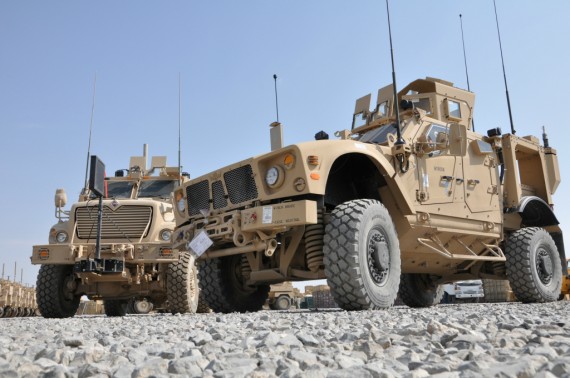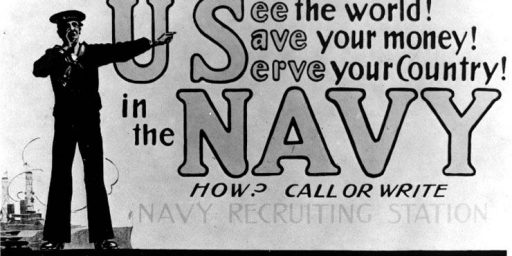U.S. To Scrap Some Military Equipment Rather Than Take It Out Of Afghanistan
About $7 billion in military equipment now in Afghanistan will be scrapped rather than returned to the U.S.
The U.S. military has decided that it will scrap some $7 billion in military equipment rather than incurring the costs and logistical nightmares associated with bringing it home from Afghanistan:
KANDAHAR AIRFIELD, Afghanistan — Facing a tight withdrawal deadline and tough terrain, the U.S. military has destroyed more than 170 million pounds worth of vehicles and other military equipment as it rushes to wind down its role in the Afghanistan war by the end of 2014.
The massive disposal effort, which U.S. military officials call unprecedented, has unfolded largely out of sight amid an ongoing debate inside the Pentagon about what to do with the heaps of equipment that won’t be returning home. Military planners have determined that they will not ship back more than $7 billion worth of equipment — about 20 percent of what the U.S. military has in Afghanistan — because it is no longer needed or would be too costly to ship back home.
That has left the Pentagon in a quandary about what to do with the items. Bequeathing a large share to the Afghan government would be challenging because of complicated rules governing equipment donations to other countries, and there is concern that Afghanistan’s fledgling forces would be unable to maintain it. Some gear may be sold or donated to allied nations, but few are likely to be able to retrieve it from the war zone.
Therefore, much of it will continue to be shredded, cut and crushed to be sold for pennies per pound on the Afghan scrap market — a process that reflects a presumptive end to an era of protracted ground wars. The destruction of tons of equipment is all but certain to raise sharp questions in Afghanistan and the United States about whether the Pentagon’s approach is fiscally responsible and whether it should find ways to leave a greater share to the Afghans.
“We’re making history doing what we’re doing here,” said Maj. Gen. Kurt J. Stein, head of the 1st Sustainment Command, who is overseeing the drawdown in Afghanistan. “This is the largest retrograde mission in history.”
The most contentious and closely watched part of the effort involves the disposal of Mine-Resistant Ambush Protected vehicles, the hulking beige personnel carriers that the Pentagon raced to build starting in 2007 to counter the threat of roadside bombs in Iraq and Afghanistan. The massive trucks, known as MRAPs, came to symbolize the bloody evolution of wars that were meant to be short conflicts but turned into quagmires.
The Pentagon has determined that it will no longer have use for about 12,300 of its 25,500 MRAPs scattered at bases worldwide, officials said. In Afghanistan, the military has labeled about 2,000 of its roughly 11,000 MRAPs “excess.” About 9,000 will be shipped to the United States and U.S. military bases in Kuwait and elsewhere, but the majority of the unwanted vehicles — which cost about $1 million each — will probably be shredded, officials said, because they are unlikely to find clients willing to come pick them up.
“MRAPs have served us well in the current war, but we will not need all that we bought for Iraq and Afghanistan in the future,” Alan Estevez, the assistant secretary of defense for logistics and materiel readiness, said in a statement. “It is cost prohibitive to retrograde and reset MRAPs that we do not need for the future.”
Scrapping military equipment rather than incurring the cost of return, or selling it off to parties who are then responsible for retrieval and tran offsportation, isn’t a new development, of course. It’s likely a bigger concern in Afghanistan given the heavy logistical costs that we’ve incurred since the beginning of the war some twelve years ago to bring equipment and personnel into the country. Since Afghanistan is landlocked, we’ve had to rely either on airlifting equipment and personnel in or bringing it in over often treacherous mountain routes via Pakistan. Both of these options are costly, which is why transportation has been among one of the most expensive parts of our expenditures in that war. Moreover, more than once during the course of the war, we’ve been at the mercy of the Pakistanis, who felt free to close off access to the mountain routes that supply caravans would need to travel to get into Afghanistan safely. Contrasted to Iraq, where access by sea via Kuwait was the most common supply route, there has just not been an easy way to get supplies into Afghanistan.
Now, we have to get all the stuff we brought into the country out of it and it only makes sense that the military would decide to scrap some equipment, especially things like the MRAPs that were specifically designed for fighting in Afghanistan and are unlikely to be used in the future, rather than incurring the cost of getting it to a U.S. base in Europe or the Continental U.S.







If the equipment is thoroughly demilitarized, then they may not be used against us in the future. If the scrap operations, recycling and repurposing helps the local Afghan economy then maybe that will be OK. I suspect the Chinese will end up with most of the scrap and they will get the benefit.
To put this in a bit of historical context, WW2 era Spitfires are still being found, buried en mass, in Myanmar.
http://www.telegraph.co.uk/news/uknews/defence/9203822/Spitfires-buried-in-Burma-during-war-to-be-returned-to-UK.html
@Matt Bernius:
As it turned out, there were no Spitfires there and the expedition literally just dug an empty hole.
We did the same thing after the Gulf War. The fact is that the operational tempo of the war simply wears equipment out. For vehicles that require depot-level rebuild (complete retrofit that returns the vehicle to zero hours, zero miles condition) it is less expensive to scrap them than to bring them home and send them to depot.
This decision should be expected and makes sense.
For me the image of the “bloody evolution of wars that were meant to be short conflicts but turned into quagmires.” will always be this:
https://upload.wikimedia.org/wikipedia/en/thumb/6/65/Kent_State_massacre.jpg/220px-Kent_State_massacre.jpg
or this:
http://consortiumnews.com/wp-content/uploads/2013/05/buddhistmonksuicied.jpg
or…
It’s basic logistics. For example when the government decided to end the construction of the super collider in Waxahachie TX it spent more to end the project than what was budgeted to complete it.
Really? Larger than the one that came at the end of WW II? Wow……….
@Donald Sensing:
I had heard the original report on NPR this past fall. I missed the follow up story. Thanks for the further info.
Doug: “especially things like the MRAPs that were specifically designed for fighting in Afghanistan and are unlikely to be used in the future, ”
Actually, in Afghanistan, Iraq, or any other place where bombs and mines are a hazard.
IOW, any likely war which isn’t a pure Air Force/Navy affair, or so small that it’s just Special Forces.
It’d cost $11billion to repatriate and overhaul the stuff bought for $7billion. ($2-3billion to haul and $8-9 billion to fix). Looks like a no-brainer.
Kruuuuugmaaaan!!!
(Broken window fallacy joke.)
And there’s also the stimulating effect of all that high quality scrap in a part of the world where it’s really expensive to transport anything.
Christ!
Cheney and his boy, GW… did THEY have the estimate of the cost of the war wrong!
Fu@k those guys again and again. Sideways.
Why not DONATE the MRAPs to Afghan army!? So that they can defend themselves and fight Taliban!?
The equipment can be used to fight the Terrorists by the Afghan army why they are scraping it !???
– Maitreya
@Maitreya:
Could it be because we’ve already equipped the Afghans to the nines, and would have to cover the cost of refitting the used items to make them useful, and that all of that would be for no good purpose as any excess largesse would end up in the hands of corrupt officials and black marketeers, and eventually in the hands of the bad guys?
Just guessing, of course.
If we find out these MRAPs were not destroyed but were secretly shipped back to the U.S. to be handed over to DHS, do we get to be not called tin foil hat anymore?